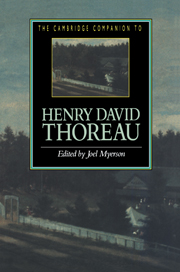Book contents
- Frontmatter
- 1 Thoreau’s reputation
- 2 Thoreau and Concord
- 3 Thoreau and Emerson
- 4 A Week on the Concord and Merrimack Rivers
- 5 Thoreau as poet
- 6 Thoreau and his audience
- 7 Walden
- 8 Thoreau in his Journal
- 9 The Maine Woods
- 10 A wild, rank place
- 11 Thoreau’s later natural history writings
- 12 Thoreau and the natural environment
- 13 Thoreau and reform
- Further reading
- Index
- Series List
9 - The Maine Woods
Published online by Cambridge University Press: 28 May 2006
- Frontmatter
- 1 Thoreau’s reputation
- 2 Thoreau and Concord
- 3 Thoreau and Emerson
- 4 A Week on the Concord and Merrimack Rivers
- 5 Thoreau as poet
- 6 Thoreau and his audience
- 7 Walden
- 8 Thoreau in his Journal
- 9 The Maine Woods
- 10 A wild, rank place
- 11 Thoreau’s later natural history writings
- 12 Thoreau and the natural environment
- 13 Thoreau and reform
- Further reading
- Index
- Series List
Summary
The narrative portion of The Maine Woods consists of separate essays based on Thoreau’s three trips (1846, I 853, 1857) to the forested mountain and lake country of north-central Maine. This region, physically the most primitive and uninhabited that Thoreau ever visited, was relatively accessible from Concord, and offered the advantages to Thoreau of available companionship, persons knowledgeable about local conditions, and hospitality before and after the wilderness adventure. The Thatchers, relatives by marriage of Thoreau’s father, resided in Bangor, the jumping-off point for lumbering operations and for sporting excursions to Moosehead Lake, Chesuncook Lake, the East and West Branches of the Penobscot River, and Mount Ktaadn (Katahdin). Near Bangor, and connected with it by a railroad, was the principal settlement of the Penobscot tribe, on Indian Island at Old Town. Thoreau’s cousin George A. Thatcher, a competent merchant, had timber interests on the West Branch, enjoyed the outdoors, and knew many of the Penobscot tribal aristocracy, the pioneer farmers along the rivers, and the lumbering speculators and sawmill owners of Bangor and Orono. He was also an antislavery activist and a pillar of his church. The Thoreaus were welcome in the Thatcher home; Sophia, the last of the family, moved to Bangor in 1873 after her mother’s death and died there three years later.
- Type
- Chapter
- Information
- The Cambridge Companion to Henry David Thoreau , pp. 124 - 141Publisher: Cambridge University PressPrint publication year: 1995
- 2
- Cited by



